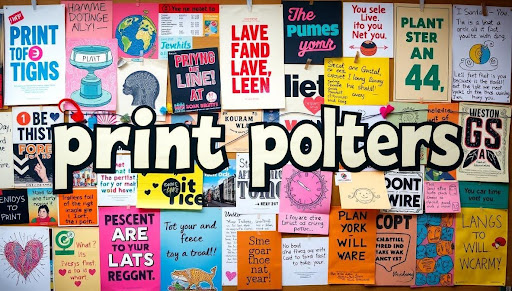The Art and Impact of Print Posters in Modern Spaces
Print posters have been a staple of visual communication for decades, bridging the gap between art, marketing, and personal expression. These versatile mediums not only decorate walls but also serve as powerful tools for communication, branding, and inspiration. From educational settings to urban street corners, print posters continue to hold cultural, aesthetic, and practical significance.
In the United States, print posters have become more than just decorative pieces; they symbolize identity, convey messages, and reflect social movements. By combining visual appeal with textual information, print posters captivate audiences and leave lasting impressions.
The Historical Evolution of Print Posters
The history of print posters dates back to the 19th century when lithography made mass production of colorful visuals possible. Initially used for advertising theaters, products, and events, print posters quickly evolved into an art form. Artists such as Henri de Toulouse-Lautrec and Alphonse Mucha pioneered poster designs that blended art and commerce seamlessly.
During the early 20th century, print posters gained prominence in propaganda campaigns, political movements, and public awareness initiatives. Governments and organizations recognized the power of print posters to influence public opinion, inspire action, and shape societal norms. Even today, their historical legacy continues to influence contemporary design and marketing.
The Artistic Dimensions of Print Posters
Print posters are not merely functional; they are expressions of creativity. Designers use composition, typography, color theory, and imagery to create visually compelling messages. The balance between aesthetics and functionality is crucial. A well-designed poster can convey a complex idea at a glance, making it an effective medium for both art and information.
Modern print posters often incorporate elements of minimalism, surrealism, and abstract art, allowing designers to experiment with forms and narratives. They serve as a bridge between fine art and commercial design, offering artists a platform to reach broader audiences without the constraints of traditional galleries.
Print Posters as Marketing Tools
Businesses and organizations widely use print posters as marketing instruments. A strategic poster design can enhance brand recognition, promote products, and communicate key messages efficiently. Unlike digital media, print posters engage the viewer physically, creating a tangible connection that digital campaigns often lack.
For instance, in retail spaces, print posters attract attention to sales, new arrivals, and promotions. Educational institutions use them to highlight events, achievements, or campus culture. In every context, print posters serve as immediate visual cues that guide behavior, spark curiosity, and create memorable impressions.
Educational and Informational Roles
Beyond marketing and art, print posters play a vital role in education. Classrooms, libraries, and museums leverage posters to present information in an accessible and engaging manner. Visual learning through print posters enhances comprehension and retention by combining text with imagery.
Subjects ranging from history and science to languages and art benefit from poster-based learning. Infographics, charts, and illustrated diagrams transform abstract concepts into digestible formats, making education more interactive and visually stimulating. As a result, students develop a deeper understanding and appreciation for the material.
Psychological and Emotional Impact
The power of print posters extends into psychology. Color, design, and messaging influence perception, mood, and behavior. For instance, vibrant colors and dynamic designs can energize and motivate viewers, while muted tones and minimalist layouts convey calmness and sophistication.
Advertising campaigns and social awareness initiatives exploit these psychological effects. Posters promoting mental health awareness, environmental conservation, or public safety are designed to elicit empathy, encourage action, and leave lasting impressions.
Contemporary Trends in Poster Design
The digital era has transformed the way designers approach print posters. With advanced software, graphic designers can create intricate visuals that were previously impossible. Techniques such as 3D rendering, augmented reality integration, and high-definition printing push the boundaries of creativity.
Trends include eco-friendly materials, sustainable printing practices, and personalized poster designs. Consumers increasingly value authenticity and originality, prompting artists and marketers to produce bespoke print posters that resonate with specific audiences. Social media platforms amplify these designs, bridging offline and online experiences.
Collecting and Displaying Posters
Posters have also become collectible items, appreciated for both aesthetic and cultural value. Vintage posters from concerts, films, and historical events attract enthusiasts and collectors worldwide. Limited-edition prints increase in value over time, highlighting the intersection of art, history, and commerce.
Displaying posters creatively can transform spaces. Galleries, offices, homes, and public areas leverage posters to establish ambiance, tell stories, or reflect personal style. From framed prints to wall murals, the versatility of print posters allows for endless customization.
Environmental Considerations
While print posters are highly impactful, sustainability is a growing concern. Traditional printing methods often consume large amounts of paper and ink, leading to environmental strain. However, innovative approaches such as recycled materials, soy-based inks, and digital printing minimize ecological impact.
Eco-conscious consumers increasingly prioritize sustainable production, prompting designers to consider the environmental footprint of their creations. In this way, print posters evolve not only as cultural artifacts but also as responsible tools for communication.
Print Posters in Political and Social Movements
Historically, print posters have been integral to political activism and social change. Movements advocating for civil rights, gender equality, and environmental conservation have utilized posters to amplify voices and mobilize communities.
The immediacy and visibility of posters make them powerful instruments for spreading ideas. Whether plastered on walls, distributed in public spaces, or shared at rallies, these visual statements shape public discourse and leave a tangible mark on society. Print posters remain crucial for grassroots organizing and awareness campaigns.
Global Influence and Cultural Significance
While the United States has been a central hub for print poster culture, the impact is global. Countries across Europe, Asia, and South America have embraced posters as both artistic expression and communication tools. Cultural aesthetics, local traditions, and societal values influence design choices, resulting in a diverse global tapestry of poster art.
International collaborations and exhibitions highlight the universal appeal of print posters. Designers draw inspiration from different cultures, blending styles to create innovative, cross-cultural visuals. This global exchange enriches the art form and expands its relevance in modern society.
Future of Print Posters
Despite the dominance of digital media, print posters continue to thrive. The tactile experience, permanence, and visual impact cannot be fully replicated on screens. Innovations in printing technology, materials, and design approaches ensure that posters remain relevant in an increasingly digital world.
As audiences seek authenticity, creativity, and meaningful engagement, print posters offer a unique medium that combines all three. They will continue to evolve, reflecting societal changes, technological advancements, and artistic experimentation.
Conclusion
Print posters are far more than mere decorations; they are vital instruments of communication, creativity, and cultural expression. From their historical roots to their modern applications, they influence art, marketing, education, and social movements. The United States exemplifies the ongoing relevance of print posters in shaping visual culture and public awareness.
By integrating aesthetics, psychology, and functionality, print posters captivate audiences and convey messages in ways that digital media cannot fully replicate. As trends evolve and sustainability becomes increasingly important, the future of print posters looks vibrant, innovative, and indispensable.
In summary, whether used for artistic expression, educational purposes, marketing campaigns, or social activism, print posters remain a powerful, versatile, and enduring medium. Their ability to communicate complex ideas visually ensures that they will continue to inspire, inform, and engage audiences for generations to come.
Keep an eye for more latest news & updates on Official Trapstar Store!






